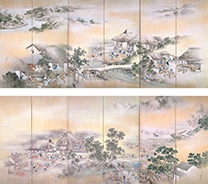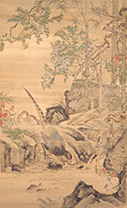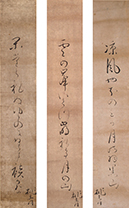Collection > Japanese Art
Hattori Collection – 20th Century French Paintings
When the new museum building was opened in 1985 a plan to systematically collect and add 20th Century French paintings to the permanent collection was announced. Art work by Georges Rouault (1871-1958), Pablo Picasso (1881-1973), and Marc Chagall (1887-1985) was purchased. At the same time, the museum asked the late Pierre Mazars (art editor for Le Figaro) to select 50 contemporary artists active in the Paris art scene, and one piece from each artist was added to the collection. Included were some artists already known in Japan, such as Maurice Brianchon (1899-1979), Paul Aizpiri (1919-2016), Bernard Buffett (1928-1999), Jean-Pierre Cassigneul (1935-)、and Antoni Clave (1913-2005) providing an overview of representational art in post war Parisian painting circles.
The Hattori Collection was named after the former museum director, who passed away in 1991, as a tribute to his achievements. The collection consists of 60 French paintings, and four sculptures, by Rodin, Maillol, and Bourdelle, which are exhibited in the Place of Virtuosos.
Yoshino Gypsum Collection - Gems of Modern French Art
In 1991 Yoshino Gypsum Co., Ltd (Tokyo) entrusted their collection of modern French paintings, with impressionist art forming the core of the collection, and additions to the collection are continuing. So far the collection includes work by; Jean Francois Millet (1814-1875), Camille Pissarro (1830-1903), Edouard Manet (1832-1883), Edgar Degas (1834-1917), Alfred Sisley (1839-1899), Paul Cezanne (1839-1906), Claude Monet (1840-1926), Pierre-Auguste Renoir (1841-1919), Henri Matisse (1869-1954), Morris de Vlaminck (1876-1958), Pablo Picasso (1881-1973), Georges Braque (1882-1963), and from the Ecole de Paris Marc Chagall (1887-1985) and Wassily Kandinsky (1866-1944). This collection has received considerable attention as one of the finest and most comprehensive domestic collections of modern French painting by artists from the Barbizon school, the Ecole de Paris, and from the Impressionist, Cubist, and Abstractionist movements.
In 2008 Yoshino Gypsum Holdings Co., Ltd established the Yoshino Gypsum Foundation for the promotion of arts (changed to a public foundation in 2011). Currently, Yoshino Gypsum Holdings Co., Ltd and Yoshino Gypsum Foundation for the promotion of arts has entrusted over 100 works to the museum, some of which are displayed in the permanent exhibition.
Shinkai Taketaro – Shinkai Takezo Sculpture Room
Taketaro Shinkai (1897-1927) was born in Yamagata, a pioneer of modern sculpture in Japan, highly acclaimed in both Bunten and Teiten exhibitions, as well as earning the title of Imperial Household Artist, he was also chosen as a member of the Imperial Fine Arts Academy. Taketaro acted as judge at the first Bunten Exhibition in 1907, while also submitting his masterpiece Bathing (bronze –plaster cast in possession of Tokyo National Museum of Modern Art, and has been designated as important cultural property). Also on display is work by his nephew Takezo Shinkai (1897-1968). He was a member of the Society for National Painting and later on the Japan Art Institute where he developed a fresh style. Both of these sculptors made their mark on the history of sculpture in Japan.
Hasegawa Collection Room
Upon completion of the annex in 1968, Kichiro Hasegawa, former chairman of Yamagata Bank, donated 163 works of art. These works of art collected over the generations of the Hasegawa family include The Narrow Road to the Deep North by Yosa Buson (1716-1783) a designated important cultural property. The present head of the Hasegawa family, Kichishige Hasegawa, made a further donation of 48 pieces in 1995, seven of which have been designated as tangible cultural property by the prefecture, listed below. Kichinai Hasegawa, chairman of the Shokusan Bank, bequeathed 81 pieces to the museum, and were donated on his behalf by his son Kenji Hasegawa in 1994. Through this collection received from the two branches of the Hasegawa family, which includes work from the Kano School, Literati Painting and the Maruyama Shijo school, the art of the Edo Period can be systematically traced.
Matsuo Basho(1644-1694) Three Mountains of Dewa
Kumashiro Yuhi(1693-1722) Pine Tree and Eagles, Plum Tree and Peacocks
Tani Buncho(1763-1840) Boat to Kumano
Tanomura Chikuden(1777-1835) Sengo Sansui
Yokoyama Kazan(1784-1837) Safflower: Cultivation and Processing
Watanabe Kazan(1793-1841) Wild Pheasants by a Mountain Stream
Kawai Gyokudo(1873-1957) Fine Rain
The above are designated by the prefecture as tangible cultural property.
Japanese Art
* Please note that some works will be exhibited for a limited period.
For details, please contact to the museum.




